Guide to rationalist interior decorating
post by mingyuan · 2023-06-19T06:47:13.704Z · LW · GW · 49 commentsContents
Lighting Lighting basics CRI (color rendering index) Color temperature Lumens Diffusion Bright lighting Lumenators Dimming Non-lumenator light fixtures Cozy lighting Dimming Decorative lights Copper wire LED lamps LED string lights Colored incandescent string lights Furnishings Rugs The rug Slippery rugs Rug pads Seating Floor chairs (’backjacks’) Couches Papasan chairs Air purifiers Aesthetics Pick a color scheme Color Plants None 49 comments
Recently someone asked me to write a guide to rationalist interior decorating, since there’s a set of products and best practices (originating with CFAR and Lightcone) that have gotten wide adoption. I’m perhaps not the very most qualified person to write this post, but I’ve been into interior decorating since before the Lightcone team got into it, and I basically know what they do, plus they’re all very busy whereas I wasn’t doing anything else with my time anyway. So here’s this post, which I have written all by myself like a loose cannon; blame me for everything.
I should point out that this post is anthropological, not normative. That is to say, this isn't a description of what I believe to be ‘optimal’ interior decorating; instead it's a guide to how to make your space more like what's come to be standard for rationalist coworking spaces and group houses in Berkeley (and to a lesser extent elsewhere — I've seen a Lightcone-style coworking space in New York and lumenators in Oxford!). That said, I do think the reason a lot of the products have gotten adoption is that they’re pretty good!
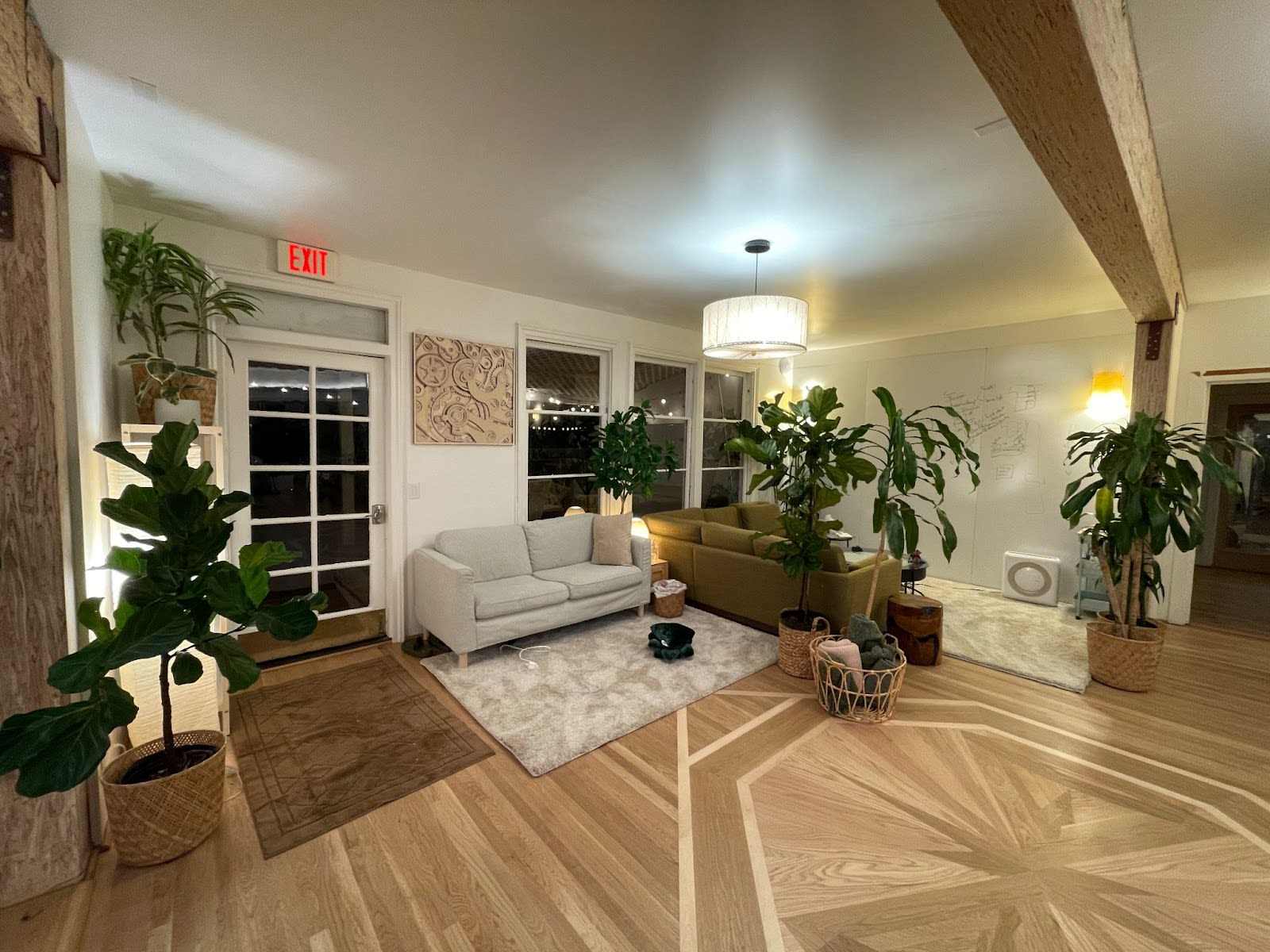
Lighting
Lighting is so important. The wrong light can give you a migraine or make you depressed. The right light can make you marvel in wonder at its beauty (like sunshine through a forest canopy, or incandescent fairy lights). I love lighting. All hail lighting.
Lighting basics
I’m going to cover mostly what you should be looking for when buying (mainly LED) lights, but if you’re interested in the topic of interior lighting more broadly, I recommend this article, which goes into more depth and technical details.
You should always be able to find the CRI, color temperature, and lumens of a product listed on the box or the online product page. I don’t think these should be different in different countries.
CRI (color rendering index)
CRI, or color rendering index, “is the measurement of how light affects how you see color”. You ideally want lights with CRI >95 but this is hard to find; 90+ is a more realistic goal and will be nearly as good, while 80+ is cheaper but noticeably worse.
CRI only applies to buying LEDs — incandescent lights all have a CRI of 100 because they, like the sun, produce light via blackbody radiation.
Color temperature
Color temperature matters a lot when choosing lights! 2700K (‘warm white’) will be noticeably yellow, 5000K (‘daylight’) will be noticeably blue, and 4000K (‘soft white’) is approximately white. The K stands for Kelvin, by analogy to blackbody radiators.
Color temperature is largely a matter of personal preference, but that doesn’t mean it isn’t important. The original lumenators used a mix of 2700K and 5000K bulbs (to imitate sunlight?), but personally I find the bluer bulbs depressing, so I use all 2700K.
Lumens
Lumens are a measure of brightness. As a reference point, the most common type of incandescent bulb (60 Watts) was about 800 lumens. Brighter bulbs draw more power (though this is mostly negligible for LEDs) and are generally more expensive.
Lumens specifically measure how much light something emits; note that the placement of lights and the characteristics of the room will affect how much light you actually receive. I like this article on the difference between lux and lumens (mainly because of the cool graphic).
Diffusion
This one isn’t a technical term, but everyone knows that looking directly at a bright light is painful / unpleasant / maybe bad for your vision. If you’re using really bright lights, you’ll probably want something that diffuses the light without absorbing too much of it. This is the purpose of lampshades, light fixtures, and the paper lanterns used on lumenators.
Bright lighting
Rationalists first got into really bright lighting to cure treatment-resistant Seasonal Affective Disorder, but it turns out that most indoor spaces are just really dark by default, so now we all just use bright lights to make ourselves more awake or happy or whatever.
Lumenators
Lumenators are the origin of the rationalist bright lighting obsession. I won’t re-explain the concept since there are several previous write-ups:
- Eliezer (2016)
- Raemon [LW · GW] (2018)
- Alex Altair [LW · GW] on alternatives to the traditional lumenator (2021)
- Chana [LW · GW] on building a lumenator in the UK (2022)
I have built three or four traditional-style lumenators, as described in Eliezer and Raemon’s posts. There’s a significant startup cost — my last one cost $500 for the materials (with $300 of that being the bulbs), and the assembly always takes me several hours and is rife with frustration — but given that they last for years, it’s worth it to me.
Buying high-lumen lightbulbs (US-centric, see here [LW · GW] for UK)
The original lumenator used 800-lumen bulbs, and they later upgraded to 1600-lumen bulbs, but that was nearly a decade ago, and LEDs have come a long way since then. Now the standard is basically just ‘as many lumens as you can get’.
I currently use these 2000-lumen A21 bulbs from Cree, which have a CRI >90. I previously used these 2600-lumen A21s from Great Eagle, which are brighter, but the CRI is only 83; I can’t remember how noticeable this was. Cree has made lumenator-suitable bulbs for many years so they're probably a good brand to check out in general.
As far as I can tell, normal-shaped lightbulbs max out around 3000 lumens. If you want more lumens from a standard (E26) lightbulb socket, try corn bulbs. I have this 95 CRI corn bulb, which is no longer available but was sold by Happyskymall. I can’t vouch for any other brand personally, but scrolling through Amazon I see corn bulbs as high as 21,000 lumens.
Beware, however — with all that power draw, corn bulbs can get pretty hot, and sometimes burn or melt things, including the sockets they’re in.
Dimming
Both A21 lightbulbs I linked are listed as dimmable, but in practice using a dimmer switch with high-powered LEDs often results in annoying buzzing and/or flickering. I basically just don’t recommend using a dimmer switch with a lumenator anymore. When it gets too late for the lumenator, I just transition to lamps and fairy lights.
Non-lumenator light fixtures
I like how the traditional lumenator – a string of 24 lights – wraps around a whole room, providing a roughly equal amount of light from all directions. (Apparently this is pleasant because the light distribution mimics that of the sun shining down from all angles? idk.) But if you don’t want to go to the trouble of building a lumenator, you can also just put really bright bulbs in a normal light fixture or lamp.
What has come to be known in the community as the ‘tofu lamp’ is made by Adesso, and comes in both floor lamp and table lamp styles. The basic appeal of these (yes I know not everyone likes them) is that they can fit many/large bulbs (the floor lamps can easily fit three corn bulbs), and they diffuse & soften the light without dimming it much. But watch out: if you have hot bulbs and your lampshade is hanging crooked, you can burn it!
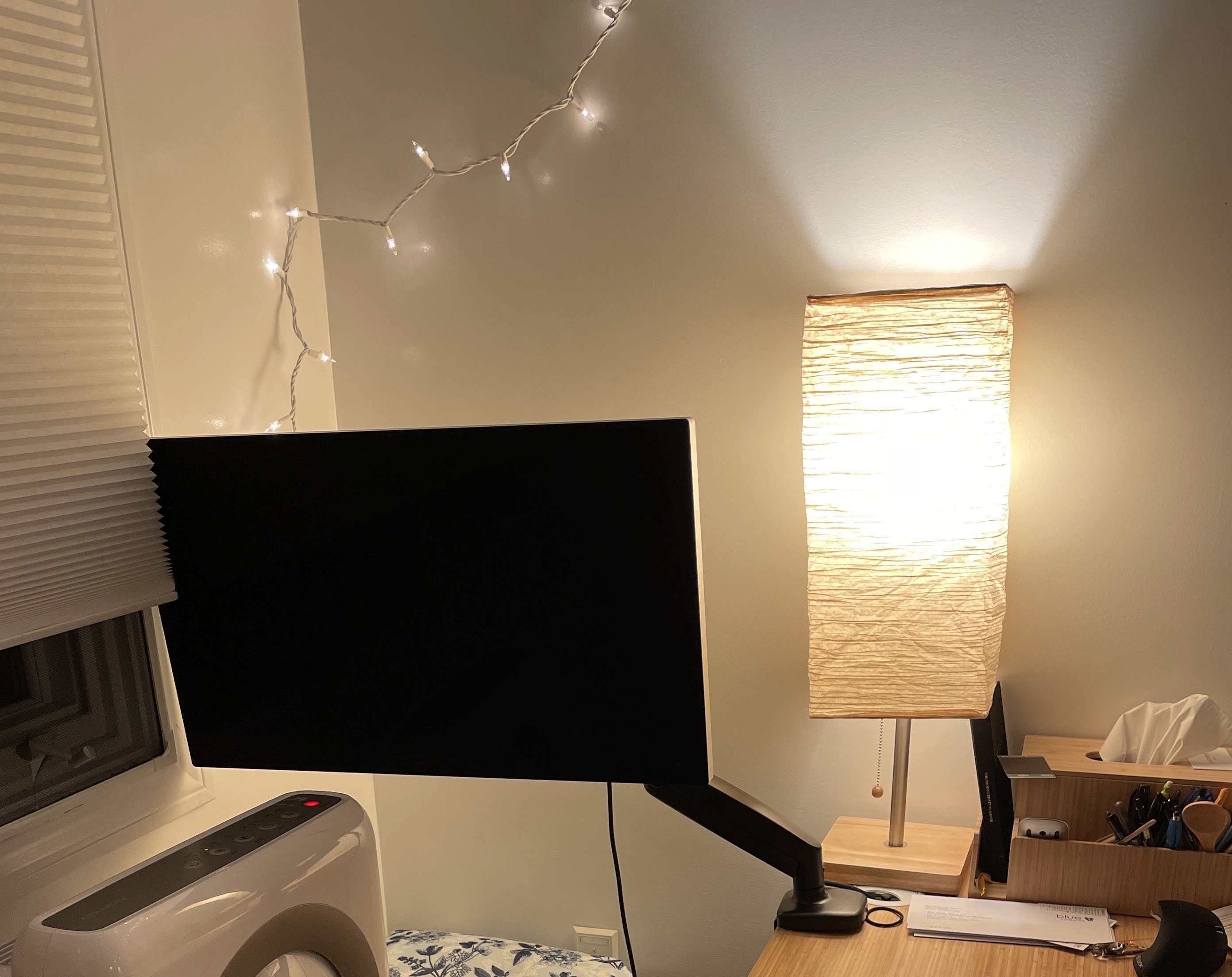
Or, if you want to go really hard: my friend just has a big array of corn bulbs in one corner of his room, diffused by a folding screen, which basically makes that whole corner of his room into one giant lamp. It’s nice because it can be incredibly bright without risking setting a lampshade on fire!
Cozy lighting
Good lighting for winding down and being cozy is very different from good lighting for staying wide awake and working. Cozy lighting should be warm in color temperature, spread out over many small point sources, and ideally of variable brightness, so that you can dim it more the closer you get to sleep.
Let me read you the gospel of incandescent string lights (aka fairy lights / Christmas lights; make sure you get them in ‘warm white’).
They’re so OP. They can instantly make the most boring room beautiful. They don’t give anyone headaches or migraines. When I introduce them to a new space, people say things like “this is so much nicer than before” and “I am happy” and “oh my god why did no one tell me it could be like this” (Andrew Critch, 2022, paraphrased).
In college, my friends wondered how my dorm room felt cozy and homey while their fundamentally identical rooms felt sterile, and the biggest reason was that they were using the overhead lights, while I had fairy lights.
idk man, just get some fairy lights. Watch them twinkle. Experience peace and happiness.
(And if you’re in the US maybe stockpile a ton of them because companies aren’t allowed to produce incandescents anymore?)
Dimming
You can plug any light (that has a plug) into a dimmer switch like this one. They generally work well with incandescents; if you're trying to dim LEDs, make sure that (a) the LEDs are listed as dimmable, and (b) the dimmer switch is listed as compatible with LEDs. If a lamp is involved probably make sure the lamp is dimmable too.
Decorative lights
These are lights that aren’t used primarily for lighting a space, but are just there to look pretty and add some twinkle. As such, the CRI isn’t nearly as important — even if the decorations cast a non-negligible amount of additional light, they should usually be overpowered by higher-CRI lights as long as they’re less bright.
Copper wire LED lamps
You can make an aesthetic lamp by stuffing copper wire LEDs into something glass — it can be a vase, a glass teapot, an empty alcohol bottle (Bombay Sapphire gin has a particularly pretty bottle), or even just a mason jar (as pictured below).
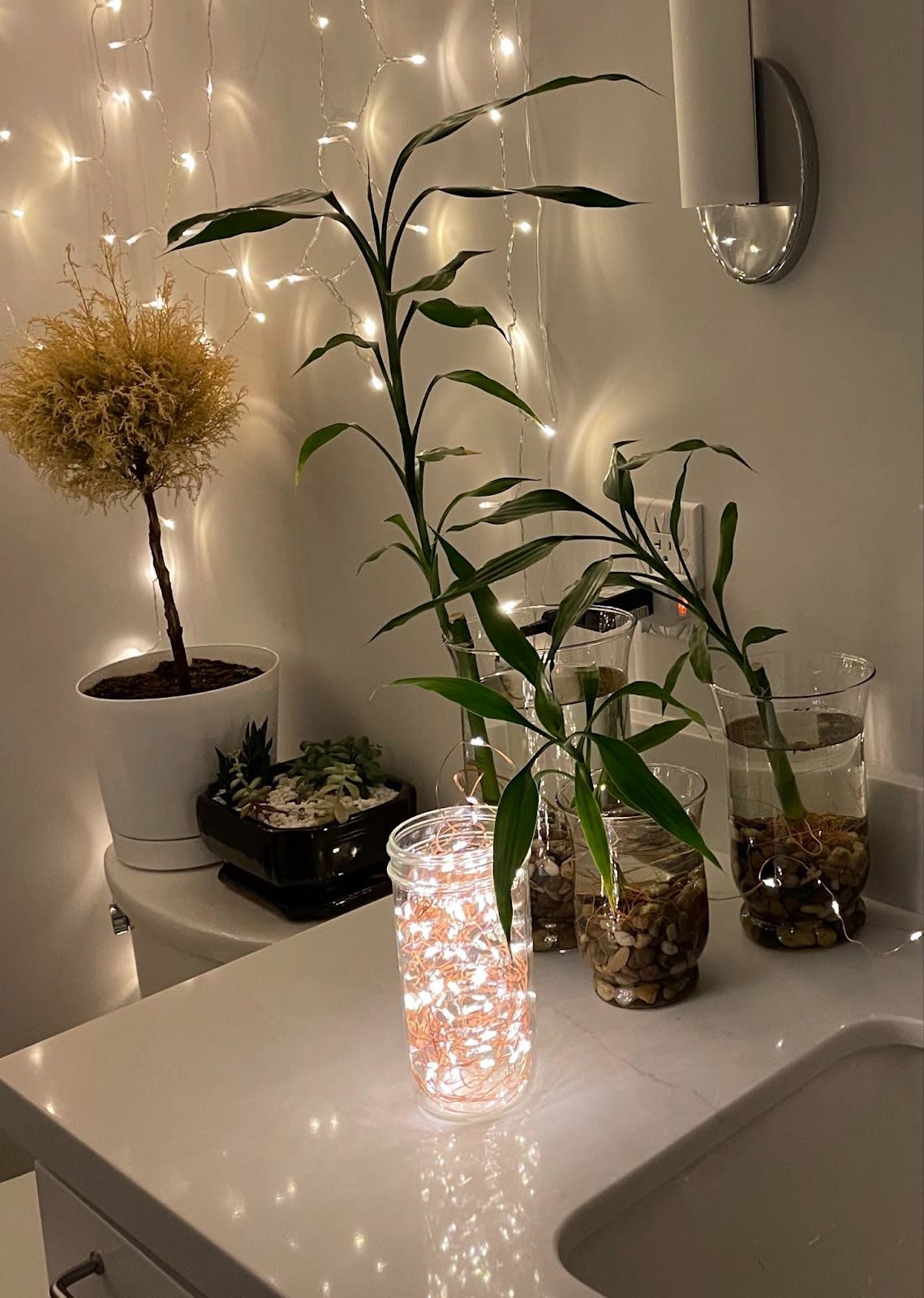
You can also use copper wire LEDs in other ways, for example, to fill a non-functional fireplace! They are pretty.

LED string lights
While LED string lights are too low-CRI to light a space pleasantly on their own (imo), they can be really nice as decoration. The lights behind the tapestry in this picture are an LED light curtain.
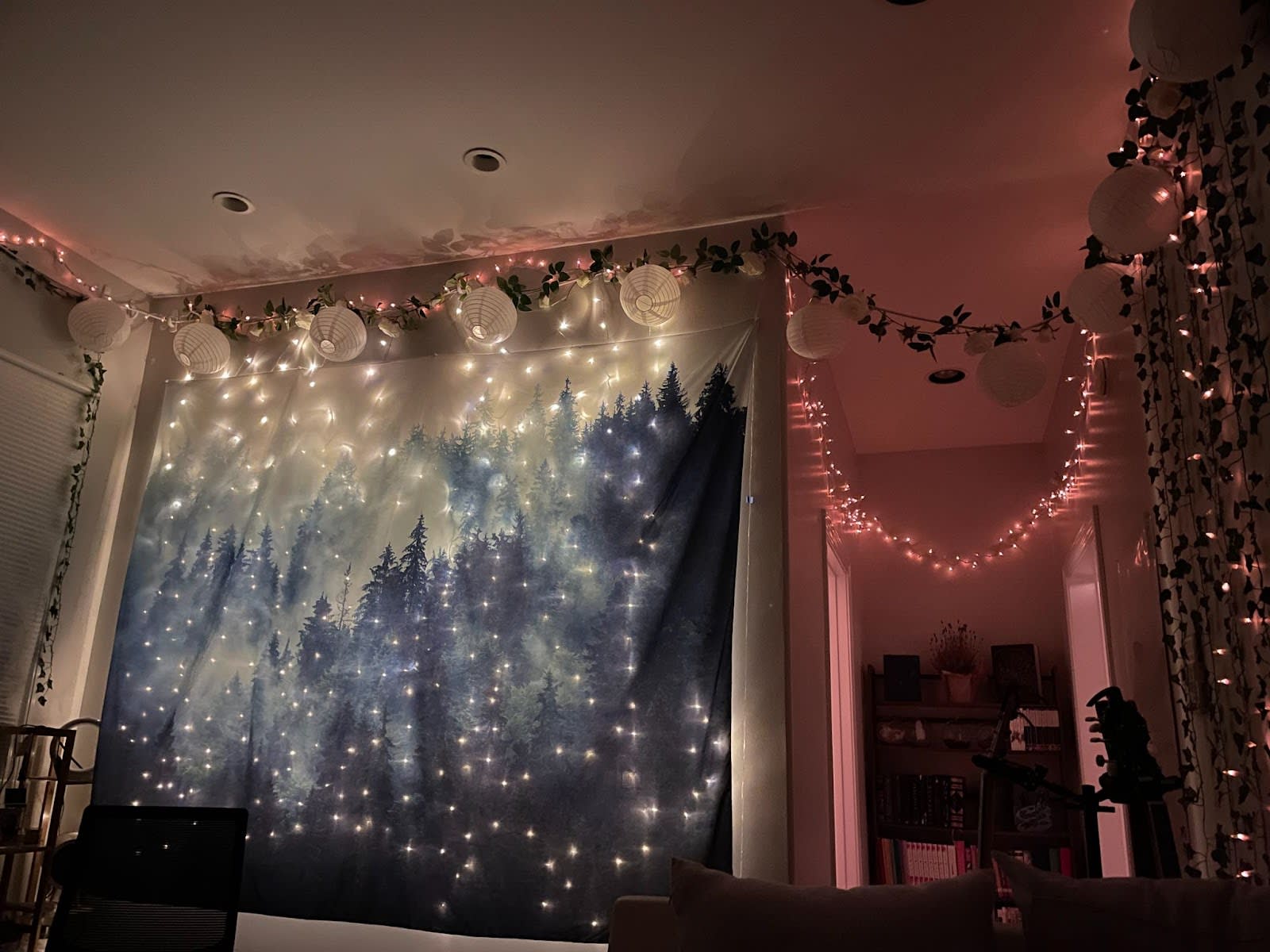
Colored incandescent string lights
Like normal string lights, but with colored bulbs. They're not great for casting much light, but they're pretty! Warm white string lights can also be used to enhance the aesthetic of a room, e.g. you can have them on during the day while your lumenator is also on.
Furnishings
Rugs
The rug
The famous rationalist rug is the Home Depot Ethereal shag rug in cream beige. It comes in seven different sizes, and there are also four other color options if you want to be original.
Why is this rug so good? Well, it’s really soft. It makes the floor an appealing place to be. Sometimes I fall asleep on it and don’t even regret it afterwards. Also it can fulfill the need to fidget because it’s fun to bury your fingers in it and make handprints and patterns.
Like any high-pile rug, it will stay nice if you vacuum it regularly, don’t wear shoes on it, and ideally keep it out of high-foot-traffic areas. And like any high-pile rug, if you don’t do these things, it will become full of dirt and allergens and not be nice to lie on anymore.
Slippery rugs
Some people really like these polyester rugs, also from Home Depot — they're incredibly soft to the touch, and if you wear socks on them they're super slippy, which can be fun I guess?
Rug pads
A rug pad serves the dual purpose of preventing the rug from sliding around on the floor, and making it squishier to step/sit/lie on. If you’re using a rug on a hardwood or tile floor and you want people to be able to sit on it for an extended period, you should get a rug pad. An alternative that doesn’t solve the slipperiness problem but does create cushion (and may be cheaper) is puzzle mats.
Seating
Floor chairs (’backjacks’)
We still call them ‘backjacks’ because BackJack was the original brand of floor chair that CFAR used, but the product you’ll see around rationalist spaces now is this folding floor chair from Birdrock Home. Some people also like this larger, swiveling floor chair, also from Birdrock Home, though this product is more suitable for permanent seating than flex seating, due to its size and weight.
I’ve heard a lot of people say that floor chairs are stupid and pointless, so let me explain the point. CFAR was the originator of rationalist floor chair use, and the reason they made such heavy use of them was that CFAR workshops involved a lot of people moving between a lot of rooms, and it wouldn’t have made sense (or been possible) to have sufficient permanent seating in every room to accommodate all the people who might ever need to sit there. This continues to apply to other retreats and workshops, but for a home or office, you might well have no need for floor chairs.
TL;DR: Floor chairs give you a lot of flexibility on how you use space. Not everyone needs this flexibility, and so not everyone needs floor chairs.
Couches
There is no one good couch. Whether or not you in particular like a given couch depends on a whole host of factors, including your weight, the length of your thighs, how you want to use the couch (working? cuddling? sleeping?), what materials you like against your skin, what position you usually sit in, etc. In my time in a group house we had at least nine different couches, and every couch had some people who loved it and some who hated it.
That said, the Ceni Sofa from Article (which you may have seen at Lightcone spaces) is pretty widely liked. It’s $1000, but couches are just pretty expensive in general; this isn’t much more than you’d spend at Ikea.
Anyway, the important thing is that your couch be comfortable for you / fit for your purposes. If at all possible, you should try sitting on a couch before deciding whether to buy it. And if buying secondhand (e.g. on Craigslist), don’t commit to the purchase until you’ve smelled the couch.
Papasan chairs
Papasan chairs are another polarizing furniture item. I hate them. They take up so much space but can generally only fit one person, and they require a stupid amount of maintenance. However, some people love sitting in a bowl, I guess.
Air purifiers
I first got into air purifiers because of wildfire season, and then everyone got into them during Covid. They can filter not only smoke and viruses, but also allergens like dust, pollen, and animal dander.
There are basically two air purifiers that everyone I know has, both of which are also on the Wirecutter list of recommended air purifiers. These are the Coway Airmega AP-1512HH and the Blueair Blue Pure 211+ (or 211 Auto). This isn’t a post about air purifiers but here are some considerations about the two:
Coway
- Easier to move around (has a handle)
- Slim profile, doesn't take up much space
- Lots of self-explanatory buttons
- For the love of fuck take the plastic covers off of the filters before running it
Blue
- Hard to move around (often falls in half)
- Comes in multiple sizes & styles (see e.g. medium size), and the biggest one moves a lot more air than the Coway, which is useful for a big space
- Nicer aesthetic (imo), and you can change the look by changing the pre-filter if you want
Aesthetics
You may notice that the aesthetic I outline below is pretty close to what might be called ‘minimalism’, and you might be like “boo I hate minimalism, why does everyone want everything to be boring and beige!” But there are reasons why this is a good basic aesthetic to recommend:
- Simplicity – A major reason to recommend minimalism is that it’s simple, and therefore relatively hard to mess up. I’m personally a big fan of well-executed maximalism, with lots of loud colors and patterns everywhere, but I wouldn’t know how to explain how to pull that off.
- Visual clutter = mental clutter – Rationalist spaces are often used for working, so you don't want to fill them with things that will be too visually distracting.
- Customizable – If I give you a really basic template, you can follow it and still make it your own.
Okay, so now for how to do it:
Pick a color scheme
In order to have a cohesive aesthetic, you want to pick out one or two each of: base colors, wood tones, and accent colors. Take this Lightcone-designed room, for example:

This room’s base colors are white and cream (walls, ceiling, rugs, air purifier, sofa on the left, whiteboards, lights). It sticks to light wood with yellowish undertones (floor, beams, artwork, wicker baskets). And its accents are brown (leftmost rug, end table, metal screwed into the beams) and green (sofa on the right, plants, some blankets, pillow on the floor).
It’s good for your base to be light, because otherwise the room is going to absorb all that light you just went to the trouble of optimizing. White and off-whites are solid options, but if that’s too boring for you, you can also go for a light color (light blue is relatively common).
Many rooms already have a wood tone in the form of flooring, or a major furniture piece like a desk or dining table. You don’t have to match this exactly, of course, but you don't want to clash with it – a simple way to think of wood tones is [light vs medium vs dark] and [reddish vs yellowish vs greyish] (I just made this up but it seems right).
Then there’s your choice of color accents. You want these to not clash with your base and wood tones, but otherwise, go with whatever appeals to you.
Color
Color accents are technically optional (unlike a base color, since if nothing else you have walls), but you will probably intrinsically enjoy some amount of color, especially if you have a lot of stark blank space.
I always felt sad in my combined kitchen / living room, until I realized that I could add color to the desolate white cabinets using peel-and-stick wallpaper! And then forever afterward I felt happy instead of desolate when I looked over into the kitchen.
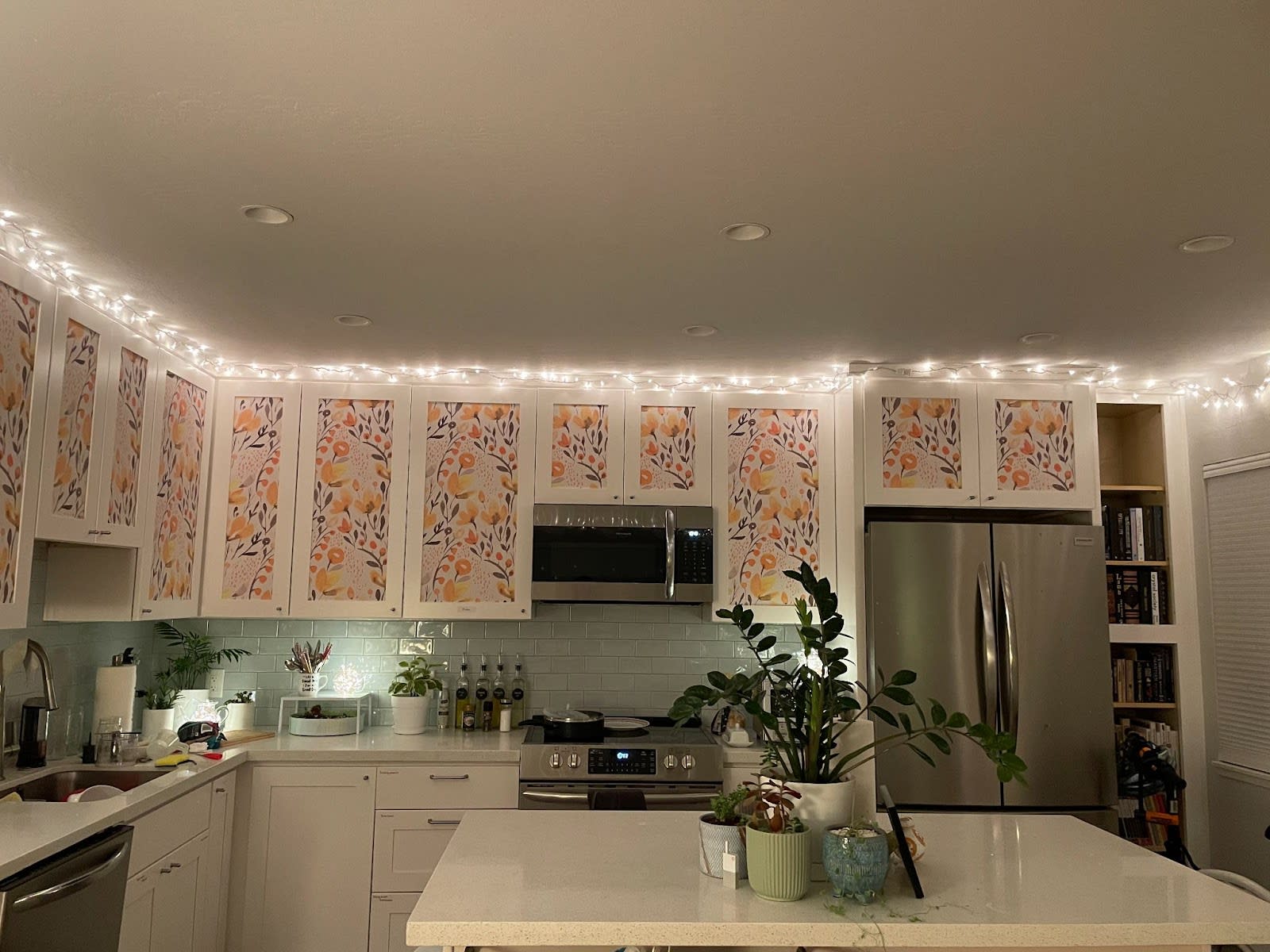
If you have a lot of blank wall space, tapestries are a relatively cheap way to cover a large area. I often recommend this for group houses, and in general I think it's more a house thing than an office thing.
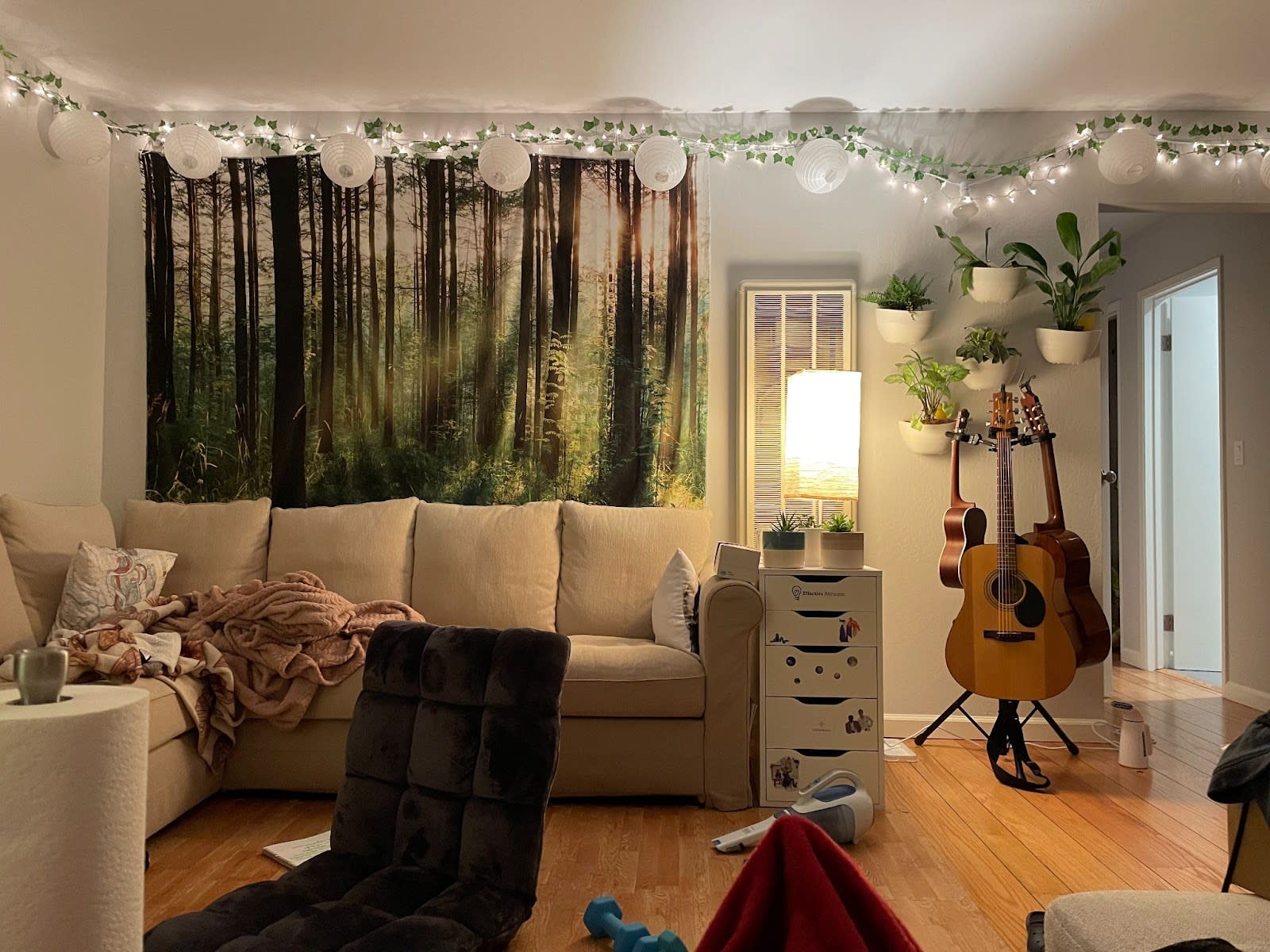
Plants
Aesthetic tastes are of course pretty subjective, but probably the closest you’ll get to a universal is that humans like looking at nature. So, incorporating plants into the aesthetic of your space is a pretty safe bet.
All else equal, it’s nicer to look at real plants than fake ones. But all else is not equal! Not everyone has the time or skill (or the money to hire someone) to take good care of real plants! So while fake plants may be worse to look at than healthy real plants, they’re still better than dead plants or no plants at all.
Another point in favor of fake plants is that you can do things with them that would be hard with real plants. For example, it’s pretty hard to cover a wall with a trailing plant, but pretty easy to hang a bunch of fake ivy. Or like, we wrapped our wedding arch with fake rose vines, and I have no idea how one would even begin to do that with real plants. Also, bonus, if you have a bird or a cat or whatever, you don’t have to worry about them being poisoned by your houseplants.
Ikea sells a variety of fake plants, many of which are pretty good. I’m not well-versed in fake plants so I mostly can’t recommend particulars, but I know people like their fake succulents.
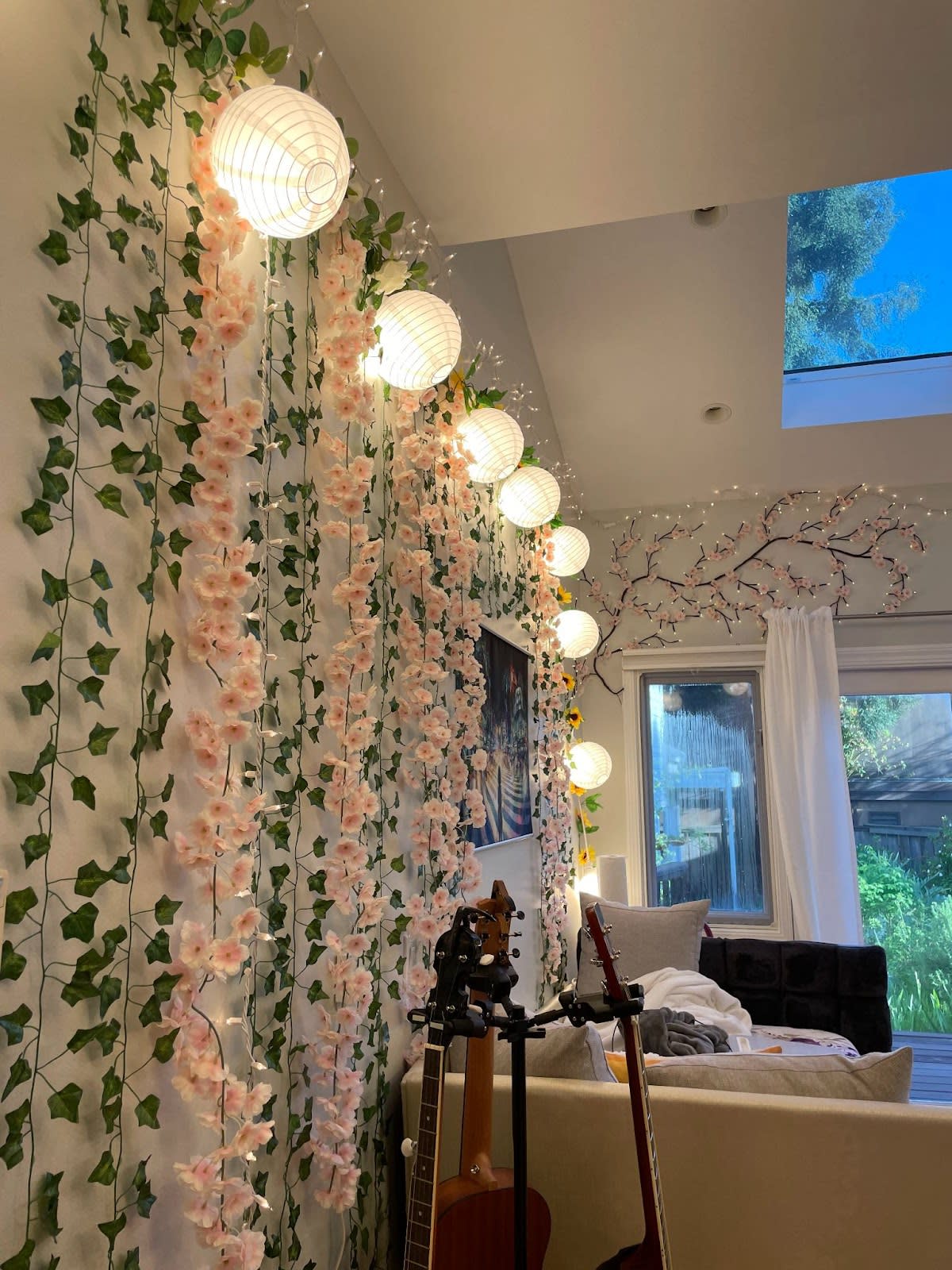
Sometimes people also say that you should have plants because they filter CO2, but this isn't actually a strong argument in favor of plants – I know some of my friends looked into this five years ago and my vague recollection is that you'd need like 100 plants per person or something to have a noticeable effect.
So there you have it. Now all the secrets have been shared with you. Go forth (or stay where you are) and decorate your living and working spaces.
49 comments
Comments sorted by top scores.
comment by nim · 2023-06-19T15:00:43.636Z · LW(p) · GW(p)
The other perk to tapestries is that they make a space echo less.
I'm surprised that you've omitted window treatments. Maybe they're just less of a thing that people think about in the spaces that you're documenting here?
tl;dr which I'd be happy to expand into a real post if it's news to anyone:
-
fabric curtains are great for adding color/pattern/texture, and/or reducing echoes, and work well in conjunction with shades for light and heat management. Also surprisingly cheap secondhand, washable, easy to swap up the look of a room. (this assumes you can mount a curtain rod or tension rod where you need it)
-
Blackout curtains in sleep spaces can be a huge quality of life improvement for folks who care about sleeping in the dark. The cheapest option is roller blinds.
-
Window treatments can have a huge impact on the thermal performance of a space, especially if it gets sunlight or wind on the exterior of the windows. Comfortable temperatures with less noise and ongoing energy use from heating/cooling are usually a win.
-
If you find yourself leaving the blinds shut because you don't want people seeing in through a window, there are lots of privacy film options. Many apply with soapy water and peel off when you pick at them, but not before. It's often sufficient to put privacy film on only the bottom half of a window, so you can still have some view to the outside.
-
When I travel outside the US, I'm baffled by how many regions missed the cultural memo about the importance of window screens. The outdoors has lots of great stuff like leaves, insects, and small birds that are good to have outside your house but annoying to have inside, and screens keep them where they belong. Screens do not impede emergency egress because the frame of the screen is held in place with relatively weak springs, and the screen itself can be torn if necessary.
-
It's possible to build impressively convincing false windows and false skylights out of old screens, but the analog version is even easier if you already have it available
I think when we talk about building our own sun with a lumenator, it can be easy to forget that actually there's also a perfectly good sun outside that many spaces can use for part of the day.
Replies from: sinclair-chen, mingyuan↑ comment by Sinclair Chen (sinclair-chen) · 2023-07-01T19:23:54.283Z · LW(p) · GW(p)
Fun fact: according to the top comment in this ask science thread, widespread window-screen installation in the US was done for the sake of malaria eradication, to slow the spread by preventing mosquitos from getting to bed-ridden people infected by the virus. This is also how bed nets work. I have not checked this at all but it sounds true.
Replies from: jai-d-no-the-other-one↑ comment by Jai (jai-d-no-the-other-one) · 2023-07-08T22:27:00.795Z · LW(p) · GW(p)
I love learning new Smallpox Eradication Lore.
↑ comment by mingyuan · 2023-06-19T16:37:16.177Z · LW(p) · GW(p)
I'm surprised that you've omitted window treatments. Maybe they're just less of a thing that people think about in the spaces that you're documenting here?
Yeah, I'd actually have a ton more to say about making a space good as it applies to your home, but it didn't all seem relevant here — e.g. the Lightcone offices were in a WeWork with windows that didn't open. (ETA: Like I said at the top of the post, this isn't a guide to what I think is optimal; that would look pretty different.)
But totally agree with everything you said about windows! I especially love privacy film:
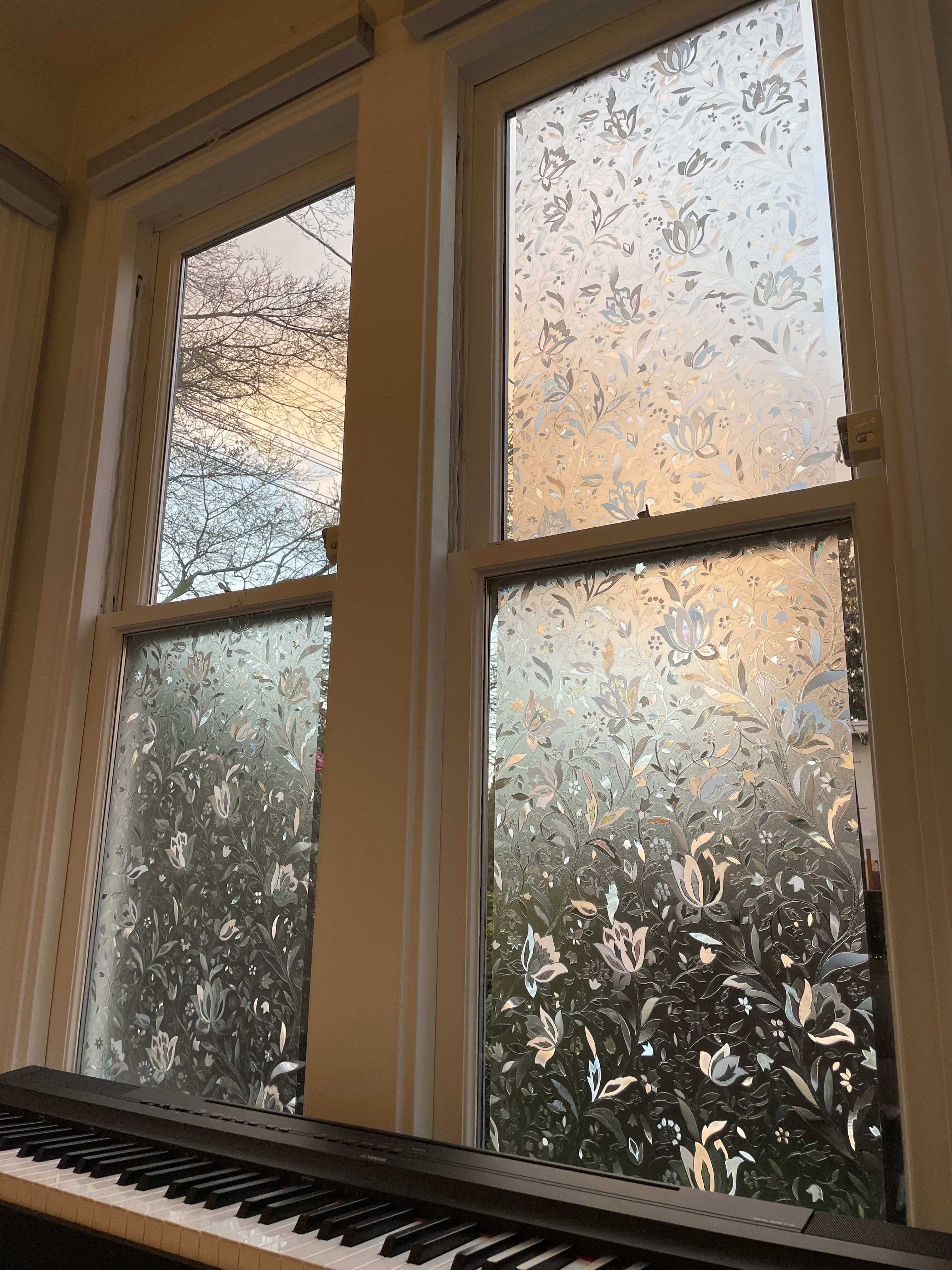
Also, California (at least the Bay Area) is one of the regions that's missed the memo about window screens – maybe because there aren't many insects? But it's indeed still super annoying to not have them, so I installed my own using this size-customizable product, which was necessary because window dimensions here appear to be completely random and not at all standardized.
Thanks for all the info you added! 💖
Replies from: dave-orr, nim↑ comment by Dave Orr (dave-orr) · 2023-06-19T20:40:29.845Z · LW(p) · GW(p)
So... when can we get the optimal guide, if this isn't it? :)
comment by JenniferRM · 2023-07-03T19:27:24.133Z · LW(p) · GW(p)
This is a great guide! I hit ^f[music] and don't see any hits, so I'll add that when I visited the Lightcone office, I was talking about something, and there was nice music in the background, and then I just had to interrupt myself, point at the speakers, and say "are we in the tropical village from breathe of the wild?... I think I love it!" and then we went back to chatting about <topic> after the nod and smile in response.
I'm not sure how standard this is, or what tools were used, but just adding this soundtrack (and stuff like it?) to the overall ambiance of the visuals and so on was quite nice :-)
comment by Going Durden (going-durden) · 2023-06-20T11:58:44.090Z · LW(p) · GW(p)
One simple trick that I applied to my apartment lately, is to break with the tradition of "proper" placement of various objects, furniture and doodads, but focus on pure functionality and natural paths that come from human laziness.
Examples:
- beverage cooler right next to the couch, NOT in the kitchen. After all, I drink beer on a couch, not in front of the sink like a madman. Same goes for the bottle opener, corkscrew etc.
- TV set is high up on the wall, almost at ceiling level. Since I watch TV/Netflix reclined on the couch, it makes no sense to place it on "eye level" since my eyes point upward not forward.
- wall clock in the bathroom, right over the mirror. Most people who bother having a wall clock keep in in the living room, but that makes little sense. The most likely situation when you need to look at the clock is when you are preparing to leave the house: while getting dressed, brushing teeth etc.
- the closet with "in house" sweats, pajamas etc is in the bathroom, right next to the bathtub/shower, so I can dress myself immediately in fresh clothes right after washing, and not streak naked around the house looking for pajama bottoms.
- "poop library". A trick well known to boomer, but largely forgotten, is to have a pile of do-eared, cheap, redundant books on a shelf right next to the toilet, when you need something to read waiting for Number 2, and do not want to spread icky on your phone.
- storage poufs. Its basically a storage box with a pillow on top, that you can use both as a chair and to keep stuff in. If you buy poufs the same height as the seat of your couch, they also work as a perfect extension to stretch your legs. Keeps all the clutter you need in my "couch space" at hand.
- door shelf. In my case its a flat rectangular bowl that I bolted to the door, and put stuff that I absolutely need to take with me when I leave the house. The shelf must be ON the door, not next to it, on eye level, so that it is impossible to open the door without seeing the contents of the door shelf, and you kinda have to take them with you, or the act of opening the door would spill the contents of the shelf all over the floor.
↑ comment by ChristianKl · 2023-06-20T12:03:16.106Z · LW(p) · GW(p)
"poop library". A trick well known to boomer, but largely forgotten, is to have a pile of do-eared, cheap, redundant books on a shelf right next to the toilet, when you need something to read waiting for Number 2, and do not want to spread icky on your phone.
My intuition would be that there's something problematic going on if it takes so long. If you have a toilet stool does it really take so long that you need to have a book?
comment by Zian · 2023-06-19T07:31:11.026Z · LW(p) · GW(p)
FYI, the Waveform article promotes the use of the Kruithof curve but that relationship between lumens and preference could not be replicated by a study from 1990 (https://doi.org/10.1177%2F096032719002200102).
Chapter 5 of a 2005 thesis ("Human lighting demands : healthy lighting in an office environment") from TU/e has specific recommendations for brightness, contrast, etc. Its DOI is 10.6100/IR594257 (https://doi.org/10.6100/IR594257).
Full citation: Aries, M. B. C. (2005). Human lighting demands : healthy lighting in an office environment. [Phd Thesis 1 (Research TU/e / Graduation TU/e), Built Environment]. Technische Universiteit Eindhoven. https://doi.org/10.6100/IR594257
Replies from: mingyuancomment by chaosmage · 2023-07-06T10:38:44.305Z · LW(p) · GW(p)
I'd like to complain that the original post popularizing really bright lights was mine in 2013: My simple hack for increased alertness and improved cognitive functioning: very bright light — LessWrong [LW · GW] . This was immediately adopted at MIRI and (I think obviously) led to the Lumenator described by Eliezer three years later.
comment by ryan_b · 2023-06-20T16:56:37.848Z · LW(p) · GW(p)
- Simplicity – A major reason to recommend minimalism is that it’s simple, and therefore relatively hard to mess up. I’m personally a big fan of well-executed maximalism, with lots of loud colors and patterns everywhere, but I wouldn’t know how to explain how to pull that off.
- Visual clutter = mental clutter – Rationalist spaces are often used for working, so you don't want to fill them with things that will be too visually distracting.
I'd like to invert and then combine these. As concrete examples for illustration, I would like to point to religious architecture and interior decoration, like stained glass windows, murals, friezes, alcoves with statues, all the way down to the baseball-Jesus level of tchotchke.
The idea here is to use maximalism to provide deliberate saturation of things which should always be kept in mind. I am confident that - but not how - this could be used for productive purposes like general problem solving, or rationality, or working in a particular field or even a specific (hard) problem.
Examples of the kind of thing I would want to include in such saturation are:
- widely applicable problem solving techniques (like breaking the problem into parts or solving a simpler problem first)
- important/fundamental constraints (like the laws of thermodynamics)
- historical examples of important problems being solved (note that to do the thing I want I require a historical and correct example, not an inspirational and apocryphal one which is the norm in textbooks and non-specialist histories)
- there is still room for the philosophical/moral/inspirational stuff (the 12 virtues, say)
comment by Said Achmiz (SaidAchmiz) · 2023-06-20T13:30:43.625Z · LW(p) · GW(p)
Can you say more about the sorts of spaces where these styles/techniques/approaches have been applied? Are they group houses? Offices? Who is there, and what do they do there, etc.?
Replies from: remizidae↑ comment by remizidae · 2023-06-24T03:00:34.120Z · LW(p) · GW(p)
I’m guessing it’s meant for group houses or other meeting spaces based on the emphasis on floor chairs and rugs. Good stuff if you’re sitting on a floor, but if you’re not in a crowded group situation, most people would prefer sitting on real chairs or couches.
comment by Screwtape · 2024-12-13T18:53:02.436Z · LW(p) · GW(p)
My recommendation for this essay's inclusion in the Best Of LessWrong collection comes down to two questions.
- Are the places decorated like this actually that nice?
- Is this a useful guide for creating those spaces?
Having been to Lighthaven (Lightcone's venue) a lot over the last year, I think the answer to 1. is a straightforward yes. Lots of other people love Lighthaven. It's possible that this style doesn't work if you're putting less oomph into it than Lightcone put into Lighthaven. I've visited a couple of homes decorated like this and think the style works pretty well.
As for 2, yeah, I think this is useful. It points out things people might not think of (colour! I didn't think about colour when decorating a space, because I hadn't sat down and thought about it or done much research. Light! Luminators are great and pointing people at them is helpful) and is organized neatly by sections.
comment by Saul Munn (saul-munn) · 2024-12-09T06:19:04.947Z · LW(p) · GW(p)
I really enjoy this post, for two reasons: as a slice out of the overall aesthetic of the Bay Area Rationalist; and, as an honest-to-goodness reference for a number of things related to good interior decorating.
I'd enjoy seeing other slices of anthropology on the Rationalist scene, e.g. about common verbal tics ("this seems true" vs "that seems true," or "that's right," or "it wouldn't be crazy"), or about some element of history.
comment by angelinahli · 2023-06-27T01:33:50.264Z · LW(p) · GW(p)
I have built three or four traditional-style lumenators, as described in Eliezer and Raemon’s posts. There’s a significant startup cost — my last one cost $500 for the materials (with $300 of that being the bulbs), and the assembly always takes me several hours and is rife with frustration — but given that they last for years, it’s worth it to me.
Reading this post inspired me to figure out how to set up a lumenator in my room, so thank you for writing it! :)
I just set mine up and FWIW I got 62,400 lumens for $87 ($3.35 / bulb if you buy 26, 2600 lumens, 85 CRI, 5000k, non-dimmable). These aren't dimmable, but are over half the price of the 83 CRI Great Eagle bulbs you mentioned (which are $6.98 / bulb right now).
My full set up [LW(p) · GW(p)] cost $212.
comment by Kaj_Sotala · 2023-06-19T22:07:39.294Z · LW(p) · GW(p)
The famous rationalist rug is the Home Depot Ethereal shag rug in cream beige. [...]
Some people really like these polyester rugs, also from Home Depot
These links give me an "Access Denied" error message.
Replies from: T3t↑ comment by RobertM (T3t) · 2023-06-19T22:35:20.978Z · LW(p) · GW(p)
Can't reproduce. Maybe some weird geofencing behavior?
Replies from: ChristianKl↑ comment by ChristianKl · 2023-06-19T22:59:18.975Z · LW(p) · GW(p)
Doesn't show to me as well. Likely, not available from the EU (Kaj and myself live in different European countries).
Replies from: Cernaelcomment by Jai (jai-d-no-the-other-one) · 2023-07-14T00:34:09.917Z · LW(p) · GW(p)
And if you’re in the US maybe stockpile a ton of them because companies aren’t allowed to produce incandescents anymore?
I just checked the DoE guidelines on this, and I think fairy lights are actually exempt! Here's the relevant paragraph (bold mine):
A general service incandescent lamp is a standard incandescent or halogen type lamp that is intended for general service applications. It has the following characteristics: (1) medium screw base; (2) lumen range of not less than 310 lumens and not more than 2,600 lumens or, in the case of a modified spectrum lamp, not less than 232 lumens and not more than 1,950 lumens; and (3) capable of being operated at a voltage range at least partially within 110 and 130 volts. This definition does not apply to the following incandescent lamps—(1) An appliance lamp; (2) A black light lamp; (3) A bug lamp; (4) A colored lamp; (5) A G shape lamp with a diameter of 5 inches or more as defined in ANSI C79.1-2002 (incorporated by reference; see § 430.3); (6) An infrared lamp; (7) A left-hand thread lamp; (8) A marine lamp; (9) A marine signal service lamp; (10) A mine service lamp; (11) A plant light lamp; (12) An R20 short lamp; (13) A sign service lamp; (14) A silver bowl lamp; (15) A showcase lamp; and (16) A traffic signal lamp. 87 FR 27461, 27480.
"Lamp" here should refer to each individual bulb. Referring specifically to the Prextex lights you linked: They do not have a medium screw base (=the standard E26 base you see in most house lamps), lumens per bulb is below 310, and each individual bulb is at just 2.5V.
This explains the lack of any "discontinued" notice or sudden price spikes or panic buying. Also, looks like there are plenty of loopholes for continued incandescent usage. It'll be a pain, and it's a dumb rule, but it's surmountable. This will be yet another area in which knowing the specifics of the dumb rules will advantage some people over others.
comment by Nissa Seru (nissa-seru) · 2023-07-06T22:40:30.401Z · LW(p) · GW(p)
thank you! this is a nice and useful post.
a few related recommendations from personal experience:
- these bulbs live further down the spectrum of more-lumen/less-CRI; i like them and use them at home: https://www.amazon.com/SANSI-Equivalent-Technology-Non-Dimmable-Efficient/dp/B0BV6CQ8JL
- i have not experimented much with higher CRI bulbs, but i suspect that i'm sufficiently deuteranomalous that i wouldn't get much value from them (low-confidence)
- very quiet, effective, air purifier, also has an app to enable scheduling etc. i have one in my office and bedroom.
- quiet, effective window ac, has app to enable scheduling etc.
- reflective insulation - i put it on windows that are not used as such to prevent heat ingress and reduce light seepage through blackout curtains (i like it very dark when sleeping)
- https://www.amazon.com/gp/product/B0002YPIOW
- this is a big roll
- https://www.amazon.com/gp/product/B0002YPIOW
comment by ada · 2023-06-21T21:14:10.536Z · LW(p) · GW(p)
Ah! Were you the one who decorated the Rose Garden Inn? I'm really curious how you made the lighting that looks like the sun coming through a cracked door / coming through the cracks between bricks.
Picture below -- I took a ton of pictures when I was there to steal your interior decoration ideas.
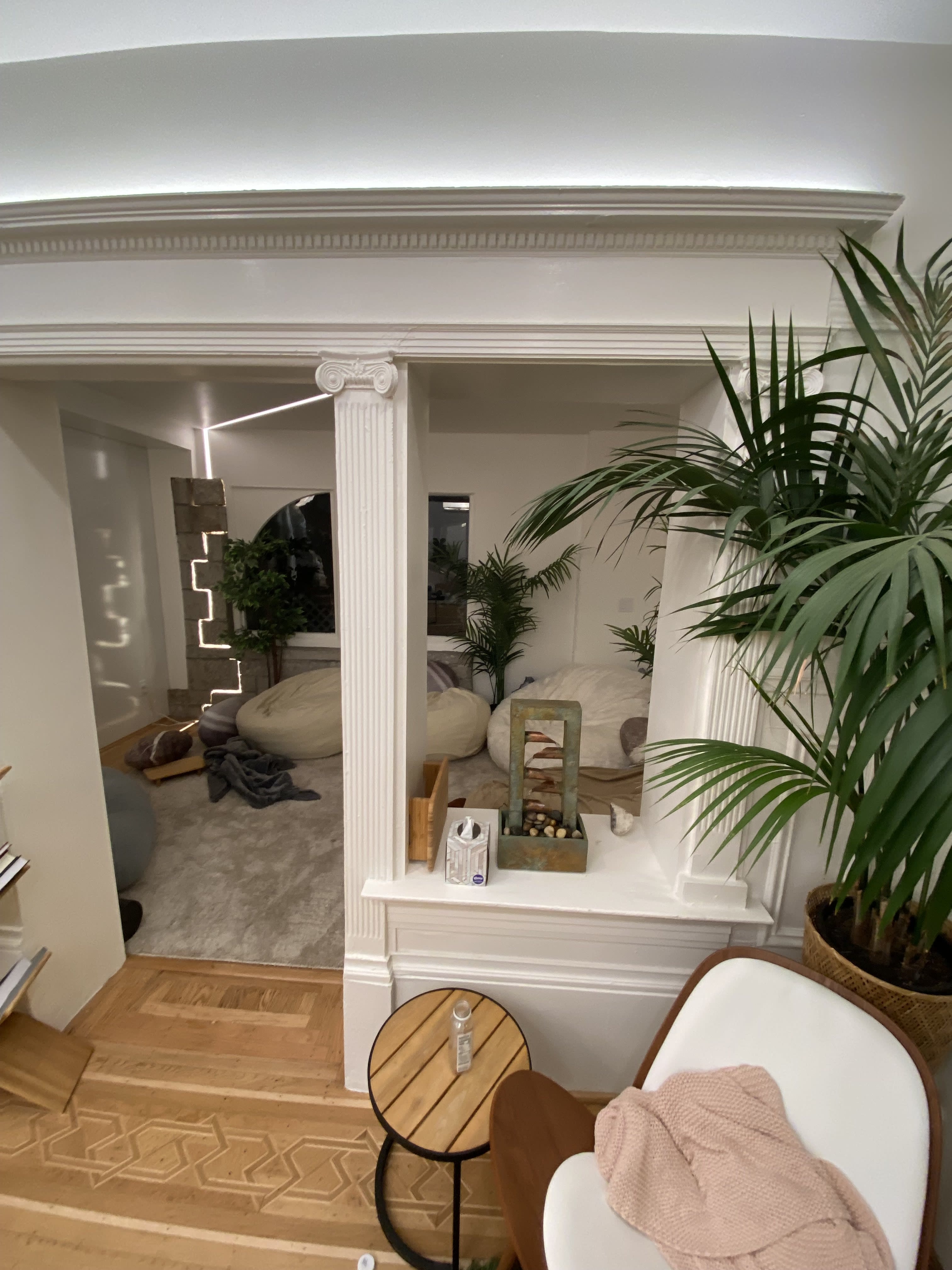
↑ comment by mingyuan · 2023-06-22T01:02:23.652Z · LW(p) · GW(p)
I have not worked on the Inn, but the search term for that kind of light is 'recessed channel lighting' :)
(I guess I should mention in the post that my recommendations were rental-space-oriented; Lightcone was able to install this recessed lighting because they own the space and can do whatever they want to it, but it's too invasive for a rental.)
Replies from: adacomment by mako yass (MakoYass) · 2023-06-24T19:05:35.205Z · LW(p) · GW(p)
not everyone needs floor chairs
I want to disagree, I yearn for the comfort of japanese style low tables, I'm having difficulty figuring out what this yearning rests on, but I'm making progress.
Surface level discussions of japanese interior decorating principles present implausible theories like "it's easier for servers to take plates when the table is lower" (it doesn't seem like it would be?), and "samurais liked it because a person's harder to attack when they're lower to the ground" (No they aren't??), though I like the theory "it allows adults and children to be at the same level".
It could be about kotatsu. It makes them a lot more convenient; a smaller blanket can be used, less air underneath the table needs to be heated, and sitters can reach the heater without having to bend down and get under the table. However, in contemporary air conditioned buildings, kotatsu may not seem so important, though I might argue that there's an important human experience being lost there and maybe we shouldn't accept it. But also: Do you know why universities, offices and restaurants are often kept at a somewhat uncomfortably low temperature? If there's a good reason for that, and there probably is, then having pockets of increased warmth, like kotatsu, maybe still makes sense?
I also notice that I'll always try to sit in a way that brings my legs up to the same level as my pelvis no matter what I'm sitting on, no matter how inconvenient it is, so being on the floor is often preferable to chairs. I'm not sure what that's about, the body knows more about its needs than I do, but there's probably data about this that we could consult.
Replies from: JenniferRM↑ comment by JenniferRM · 2023-07-03T19:40:45.045Z · LW(p) · GW(p)
I think offices are kept at a "low" temperature because there is actually wide variation in temperature preferences and tolerances among normal humans, and maybe also because it is considered easier for women and skinny people to add a sweater than for others to change gender, lose weight, or wear ice packs.
I think I approve of this for spaces that aren't going to have kids, but I think that for kid-centric spaces a higher temperature than is maximally comfy for large men is still correct? Maybe?
(Or you could try to maintain gradients and zones? I've found heated seats in cars to be really nice for accommodating groups with diverse temperature preferences, and maybe the heater under the table is enabling something similar?)
I yearn for the comfort of japanese style low tables... I like the theory "it allows adults and children to be at the same level".
+1 <3
Replies from: MakoYass↑ comment by mako yass (MakoYass) · 2023-07-04T00:05:28.900Z · LW(p) · GW(p)
but I think that for kid-centric spaces a higher temperature than is maximally comfy for large men is still correct? Maybe?
Oh you mean like, 6-13 year old kids? Yeah maybe.
Replies from: JenniferRM↑ comment by JenniferRM · 2023-07-04T21:35:55.614Z · LW(p) · GW(p)
Or a pre-school or kindergym or (if a building design is opulent enough to offer room-specific temperature control) a two-year-old's bedroom?
Small bodies have much higher surface area to volume ratios, and a 10 month old can barely even explain the problem they face!
In grocery stores when I was really little, I'd stay "just outside" the cold aisle, and then run to the other end to try to avoid the chill, when along with parents on a shopping trip who wanted to loiter in the middle of it. It was only much later that I understood the physics of why they weren't bothered, and the psycho-politics of why no one optimized that stuff "for me".
Replies from: MakoYass↑ comment by mako yass (MakoYass) · 2023-07-05T01:21:27.897Z · LW(p) · GW(p)
I just don't remember ever minding cold as a child. Yes, I would run through the freezer isle, or jump around to keep my feet off the ground and to stay warm, but I would enjoy the running, it would fully address the problem for me. With pre-school kids, I feel like they're always moving around a lot in this way, but I'm not sure.
comment by AnthonyC · 2023-06-20T14:55:47.664Z · LW(p) · GW(p)
Just a heads up there are, in fact, some very nice LED fairy lights that are close to indistinguishable from incandecents.
Replies from: mingyuan, kave↑ comment by mingyuan · 2023-06-27T19:50:07.604Z · LW(p) · GW(p)
Okay I bought the specific LED lights you linked, and I have to disagree. The color temperature is nice enough, but they have a very noticeable refresh rate, such that if I wave them back and forth my eyes have trouble keeping track of them. I don't think these are any better than other LED string lights I have, and my husband thinks they're probably worse (more noticeable flicker, though perhaps comparable CRI). I would definitely not light a space with them.
That said, I'm not put out about having spent $10 on these, because they're supposedly meant for outdoor use, and I wanted our front porch to be more illuminated anyway and basically don't care about the light quality there. And the claim did seem worth testing!
Replies from: AnthonyC↑ comment by kave · 2023-06-21T06:15:39.715Z · LW(p) · GW(p)
Link?
Replies from: AnthonyC↑ comment by AnthonyC · 2023-06-21T23:05:56.637Z · LW(p) · GW(p)
I personally like these ones: https://www.amazon.com/dp/B018RUJXHU?ref_=cm_sw_r_apan_dp_96CF1H2HVD33872BA4MF
Replies from: mingyuan↑ comment by mingyuan · 2023-06-22T02:54:59.454Z · LW(p) · GW(p)
Interesting, I'll have to get some and see what I think! I usually steer clear of battery-pack lights because of some experiences where they died almost immediately, so I wouldn't have stumbled upon them myself. I am really sensitive to light quality though, so we'll see :)
comment by moonlight (hex110) · 2025-01-15T18:42:17.732Z · LW(p) · GW(p)
Good reference for decorating in an intentional manner, I really like these kinds of posts discussing various aspects we tend to just do automatically, and bring a "smarter" way to approach them. It made me reconsider the importance of lighting in my room and helped me realize that "oh, yeah, that's actually important, and this is actually a good idea! I'll do that." I hope we can start seeing more posts like this.
comment by davekasten · 2024-02-15T14:49:11.987Z · LW(p) · GW(p)
I would like to thank you for this post and for encouraging me to get a ball of fairy lights, which provides me with a genuinely unexpected amount of joy whenever I look at it up close.
comment by Review Bot · 2024-02-15T14:47:41.537Z · LW(p) · GW(p)
The LessWrong Review [? · GW] runs every year to select the posts that have most stood the test of time. This post is not yet eligible for review, but will be at the end of 2024. The top fifty or so posts are featured prominently on the site throughout the year.
Hopefully, the review is better than karma at judging enduring value. If we have accurate prediction markets on the review results, maybe we can have better incentives on LessWrong today. Will this post make the top fifty?
comment by Ericf · 2023-06-20T03:05:21.990Z · LW(p) · GW(p)
So, hashtag "tell me the Rationalist community is neurodivergent without telling me they are neuro-divergent"?
Replies from: JenniferRM↑ comment by JenniferRM · 2023-07-03T20:15:23.221Z · LW(p) · GW(p)
Oooh! High agreement on something this downvoted is curiosity catnip!
(Currently I see -18 for position, and +7 for agreement... I haven't touched either button, but I'll definitely upvote a response to my questions here <3)
I thought "this is nice" would be a common human reaction, but apparently I'm miscalibrated?
The "agreement votes" suggest that even people who think you're being mean kinda grudgingly admit that you're saying something accurate...
...but like... What?
Don't "normal people" also like in a basic public space (that isn't a museum or a dance club or a bedroom or... etc) that are clean bright soft simple naturalistic spaces?
I'm honestly curious if some things that I think of as kinda sorta universally joyful are actually "mere" parochial preference?
One possibility that I'm considering is that by "neuro-divergent" you just mean "smart and thoughtful and hopeful and optimistic, and willing to try things according to naive first principles just in case they turn out as great as it seems like they'd turn out, and generally having an uncrushed spirit"?
It does seem to me like maybe normal people are extremely sad and broken a lot of times, and maybe that's all you're pointing to somehow, but that's a self-congratulatory theory, and also it isn't very predictive of any details, and so my default mental move is to doubt it and test it.
Hence: can you explain what you meant by that? :-)
Replies from: Ericf↑ comment by Ericf · 2023-07-06T04:03:54.493Z · LW(p) · GW(p)
Neurotypicals have weaker preferences regarding textures and other sensory inputs. By and large, they would not write, read, or expect others to be interested in a blow-by-blow of asthetics. Also, at a meta level, the very act of writing down specifics about a thing is not neurotypical. Contrast this post with the equivalent presentation in a mainstream magazine. The same content would be covered via pictures, feeling words, and generalities, with specific products listed in a footnote or caption, if at all. Or consider what your neurotypical friend's Facebook post about a renovation/new house etc. Emphasize: typically it's the people, as in "we just bought a house. I love the wide open floor plan, and the big windows looking out over the yard make me so happy" in contrast to "we find that the residents are happier and more productive with 1000W of light instead of the typical 200."
#don'texplainthejoke